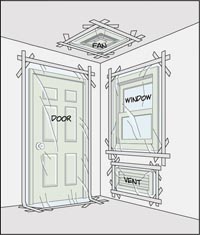EPA Study Finds Shelter-in-Place Guidelines Offer Potential Protection

Image of recommended sealing techniques used for sheltering-in-place. Visit the Department of Homeland Security Web site![]() for more details on creating a "shelter-in-place."
for more details on creating a "shelter-in-place."
A new EPA study confirms the potential effectiveness of Department of Homeland Security (DHS) guidelines for preparing in-house shelters as a way to protect against the hazards of an airborne biological, chemical, or radioactive agent. The DHS guidelines recommend that people create an in-place shelter in their homes by using an interior room which has few or no windows and sealing openings with plastic sheeting and duct tape.
According to Tim Oppelt, Director of EPA's National Homeland Security Research Center (NHSRC) which conducted this evaluation of the DHS guidelines, "Our research suggests that the use of Department of Homeland Security guidance appears to offer additional protection against exposure to airborne contaminant events. Being indoors provides protection. However, applying the guidance to seal an interior room provides an additional measure of protection under most conditions."
Results indicate that proper sealing can make a substantial difference in the effectiveness of the shelter, and is most beneficial if individuals enter the shelter before the arrival of a cloud of hazardous agent and exit the shelter as soon as the cloud passes over. Individuals who both enter and exit the shelter too late could, in some instances, actually increase their exposure over the outdoor exposure alone.
Results also indicate that most individuals can stay in the shelter for up to three hours before the air has the potential to become unhealthy. Individuals with respiratory problems may have less tolerance. Certain conditions that may result in unhealthy air include increased occupancy, a lower air flow rate, increased carbon dioxide emission rates, increased activity resulting in oxygen depletion, or longer occupancy time.
The study results are published in the online Journal of Hazardous Materials, a periodical that deals with environmental control, risk assessment, impact and management. While this study was conducted specifically to evaluate shelter-in-place measures in residential houses, additional research is planned to evaluate the effectiveness of in-place shelters for use in commercial buildings.
To learn more about the efforts of EPA's National Homeland Security Research Center, visit http://www.epa.gov/nhsrc. Additional information on DHS guidelines can be found at http://www.ready.gov/stay_or_go.html#stay. ![]()
![[logo] US EPA](https://webarchive.library.unt.edu/eot2008/20081109131352im_/http://www.epa.gov/epafiles/images/logo_epaseal.gif)